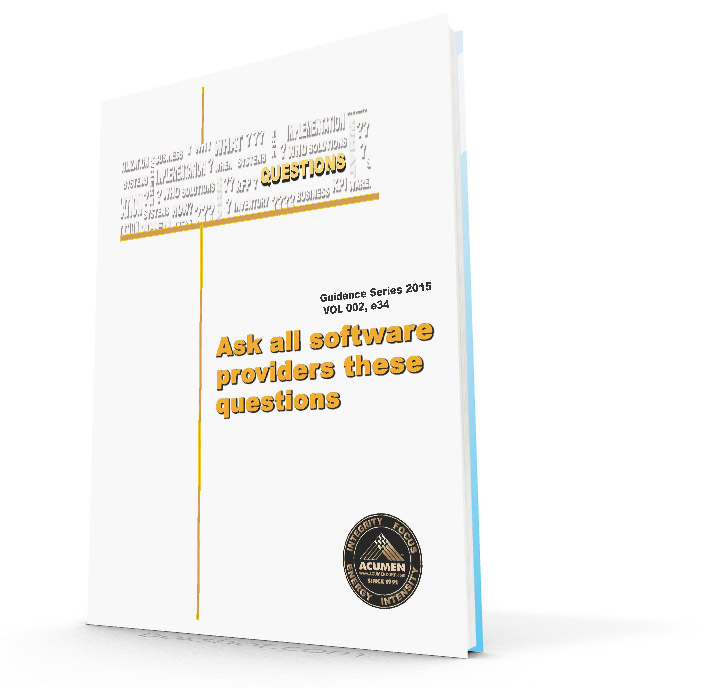Several years ago my partner Sandra Dube and I were the subject of a cover article in Enterprise Virginia magazine. On the cover she and I were pictured inside the sweltering Virginia House Museum holding actual medieval battle swords. It was agony, but that’s a different story for another day.
The subject of the magazine article was the fact that our reputation had been built on “rescuing” failing or failed ERP and accounting software implementations. At the time we represented no software developers but were often called upon by those companies and/or their clients to re-visit implementations done by other firms (or in-house resources of the developers themselves) that had gone into the metaphorical ditch. We were quite good at these rescues for several reasons, not the least of which was our ability to listen very carefully to the actual needs of the client and formulate an approach that would meet those needs directly. At the time establishing an understanding of the investment of human capital to properly deploy a solution flew in the face of the software industry’s push to place licenses and under value the implementation effort. I’d like to think things have changed since then but, alas, I see the same tendencies even today.
As a result of the above trend many manufacturers and distributors ended up with systems that were ill suited to their long term requirements. Most fell into one of two categories:
- Disparate systems cobbled together to address varied needs in the areas of accounting, sales order processing, manufacturing if applicable, shipping…you get the picture
- Actual end to end systems that were improperly implemented, highly modified and no longer supportable by the people who built them or those to installed and modified them.
One of the most unfortunate examples came just a few years ago when we encountered a fairly large company with a legacy system more than 10 years old. It had been highly modified, only upgraded once or perhaps twice during that period and was unsupportable by the manufacturer. To make matters worse the person responsible for the modifications had long since retired. That company faced a critical juncture. While the software worked for the moment, they were facing the daunting thought that it could simply fail one day and leave them unable to transact business except manually. The alternative was to identify an end to end solution that met their needs now, anticipated their future needs and was based upon a well-developed “roadmap”.
Our firm eventually began to represent software products, most notably SAP Business One and OpenAccounts, for one clear cut reason. We felt that a business system properly implemented the first time brought long term viability and stability to the client enterprise. We decided that marrying our tried and true methodology to well-crafted software would insure that our clients were supportable for years to come.
As we entered the software licensing marketplace we came to realize that our most significant competitor was “do nothing”. In other words some companies understandably took a hard look at the cost of rolling out a new system, then had a look at what it would cost to continue to provide ad hoc care and feeding of legacy systems and decided to put off the investment in ERP software. And in reality they were only putting off the investment. In fact, in our experience those companies who decide to stand pat end up spending inordinate amounts of money during the ensuing years plugging the holes in the legacy system, searching for support, paying ever increasing maintenance fees and continuing to hire, train and retain in house resources to keep the system or systems running.
Consider these realities when deciding which direction is right for your company:
- If you have multiple systems serving the needs of various sections of your company you are likely creating more work in that multiple points of entry are necessary to flow from order to cash. That can cost you dearly in human resources expenses, productivity loss and error correction.
-or-
- If you have cobbled together disparate systems to avoid multiple entry points even those integration points need support since they are often customized by the vendor. That means added expense if and when upgrades are needed for any of the component systems.
-or-
- If you have a highly modified ERP legacy system (as did our example company aforementioned) you run the risk of losing your programming support personnel or that the modifications become so significant you are “rev locked” or stuck with your unsupportable software at its current level. That normally means that the developer will ultimately stop supporting the level of your software that is “locked”.
And a word about competitiveness in your marketplace. You may have seen our “You Can’t Sell What You Can’t Ship” ads online and in newspapers and magazines. Over the past few years more businesses have demanded rapid turnaround and high service levels. That means ready access to inventory numbers including historical utilization and seasonal trends has become more critical. Many company owners and their sales managers realize that they must deploy the best tools to stay competitive. The truth is, your competitors may already be leaping ahead by deploying end to end business management systems and investing the time and money to do it right the first time.
So a word to the wise; consider all factors when making the ultimate decision on the direction of your mission critical enterprise systems. If you look closely you may find that the cost of doing nothing far outweighs the cost of moving to a system that will take you into the future.
Just sayin.
P.S. The company mentioned above elected to implement SAP Business One and partner with us using our solid implementation methodology. They are now set for viability and growth well into the future.



